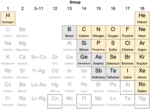A metalloid is a chemical element which has a preponderance of properties in between, or that are a mixture of, those of metals and nonmetals. The word...
246 KB (27,797 words) - 13:04, 27 August 2024
sources that list elements classified as metalloids. The sources are listed in chronological order. Lists of metalloids differ since there is no rigorous widely...
80 KB (4,411 words) - 09:25, 21 June 2024
The chemical elements can be broadly divided into metals, metalloids, and nonmetals according to their shared physical and chemical properties. All elemental...
66 KB (9,098 words) - 18:15, 30 October 2024
Antimony (category Metalloids)
Sb (from Latin stibium) and atomic number 51. A lustrous grey metal or metalloid, it is found in nature mainly as the sulfide mineral stibnite (Sb2S3)...
60 KB (6,862 words) - 00:48, 30 October 2024
the transition metals to their left and the chemically weak nonmetallic metalloids to their right have received many names in the literature, such as post-transition...
124 KB (15,306 words) - 16:20, 28 October 2024
gebrauchten und von mehreren angenommenen Benennungen Kali-Metalloid and Natron-Metalloid, bis zur völligen Aufklärung der chemischen Natur dieser räthzelhaften...
69 KB (8,043 words) - 01:28, 30 October 2024
recognized as nonmetals. Additionally, some or all of six borderline elements (metalloids) are sometimes counted as nonmetals. The two lightest nonmetals, hydrogen...
186 KB (16,953 words) - 11:05, 23 October 2024
dictionary. 33 may refer to: 33 (number) 33 BC AD 33 1933 2033 Arsenic, a metalloid in the periodic table 33 Polyhymnia, an asteroid in the asteroid belt...
2 KB (283 words) - 20:00, 30 October 2024
an orthorhombic space group. It is the most important source for the metalloid antimony. The name is derived from the Greek στίβι stibi through the Latin...
11 KB (987 words) - 13:43, 27 October 2024
Silicon (category Metalloids)
crystalline solid with a blue-grey metallic luster, and is a tetravalent metalloid and semiconductor. It is a member of group 14 in the periodic table: carbon...
87 KB (10,733 words) - 13:57, 1 November 2024
The origin and usage of the term metalloid is convoluted. Its origin lies in attempts, dating from antiquity, to describe metals and to distinguish between...
26 KB (3,086 words) - 06:49, 17 July 2024
gebrauchten und von mehreren angenommenen Benennungen Kali-Metalloid and Natron-Metalloid, bis zur völligen Aufklärung der chemischen Natur dieser räthzelhaften...
94 KB (10,892 words) - 06:02, 22 October 2024
the only one having all three types of elements: metals, nonmetals, and metalloids. The p-block elements can be described on a group-by-group basis as: group...
19 KB (2,487 words) - 01:45, 3 November 2024
List of alternative nonmetal classes (category Metalloids)
elements such as silicon, chlorine, and helium are classed as either metalloids, halogens, or noble gases, the remaining unclassified nonmetallic elements...
18 KB (1,371 words) - 09:34, 21 June 2024
ions, in the form of carbide (C4−) ions. Silicon and germanium, both metalloids, each can form +4 ions. Tin and lead both are metals, while flerovium...
32 KB (3,841 words) - 07:33, 22 October 2024
preceding 33 one of the years 32 BC, AD 32, 1832, 1932, 2032 Germanium, an metalloid in the periodic table 32 Pomona, an asteroid in the asteroid belt The...
2 KB (340 words) - 13:32, 14 November 2023
nonmetal 3 Phosphorus (P) 15 Other nonmetal 4 Arsenic (As) 33 Metalloid 5 Antimony (Sb) 51 Metalloid 6 Bismuth (Bi) 83 Other metal 7 Moscovium (Mc) 115 other...
34 KB (4,046 words) - 08:21, 29 October 2024
Difluoride (section Nonmetal and metalloid difluorides)
Difluorides are chemical compounds with two fluorine atoms per molecule (or per formula unit). Metal difluorides are all ionic. Despite being highly ionic...
6 KB (436 words) - 19:27, 23 September 2024
Arsenic (category Metalloids)
chemical element with the symbol As and the atomic number 33. It is a metalloid and one of the pnictogens, and therefore shares many properties with its...
131 KB (14,364 words) - 03:07, 30 October 2024
Metal cluster compound (section Metalloid clusters)
1002/chem.200902815. PMID 20077544. A. Schnepf; H. Schnöckel (2002). "Metalloid aluminum and gallium clusters: element modifications on the molecular...
15 KB (1,607 words) - 07:00, 23 July 2024
manganese to 6.3 × 105 S/cm for silver. In contrast, a semiconducting metalloid such as boron has an electrical conductivity 1.5 × 10−6 S/cm. With one...
94 KB (11,216 words) - 05:01, 30 September 2024
rare and highly radioactive metal (although sometimes classified as a metalloid) with no stable isotopes, polonium is a chalcogen and chemically similar...
77 KB (8,378 words) - 14:49, 2 November 2024
conduct electricity, nonmetals, which do not, and a small group, (the metalloids), having intermediate properties and often behaving as semiconductors...
75 KB (9,807 words) - 12:50, 1 November 2024
Smart inorganic polymers (SIPs) are hybrid or fully inorganic polymers with tunable (smart) properties such as stimuli responsive physical properties (shape...
18 KB (2,031 words) - 16:42, 9 October 2024
Boron (category Metalloids)
atomic number 5. In its crystalline form it is a brittle, dark, lustrous metalloid; in its amorphous form it is a brown powder. As the lightest element of...
127 KB (13,568 words) - 12:21, 31 October 2024
an inorganic, nonmetallic solid material comprising metal, nonmetal or metalloid atoms primarily held in ionic and covalent bonds. Ceramic may also refer...
2 KB (227 words) - 20:39, 21 October 2024
Nonmetals show more variability in their properties than do metals. Metalloids are included here since they behave predominately as chemically weak nonmetals...
34 KB (4,571 words) - 06:57, 3 May 2023
manganese, nickel, or zinc) and sometimes non-metals, such as phosphorus, or metalloids, such as arsenic or silicon. These additions produce a range of alloys...
44 KB (4,882 words) - 17:29, 7 October 2024
Metal and metalloid synthesis process by electrolysis...
7 KB (865 words) - 13:55, 20 October 2024
The elemental class includes metals, intermetallic compounds, alloys, metalloids, and nonmetals. The Nickel–Strunz classification system also includes...
8 KB (739 words) - 11:47, 15 August 2024


















